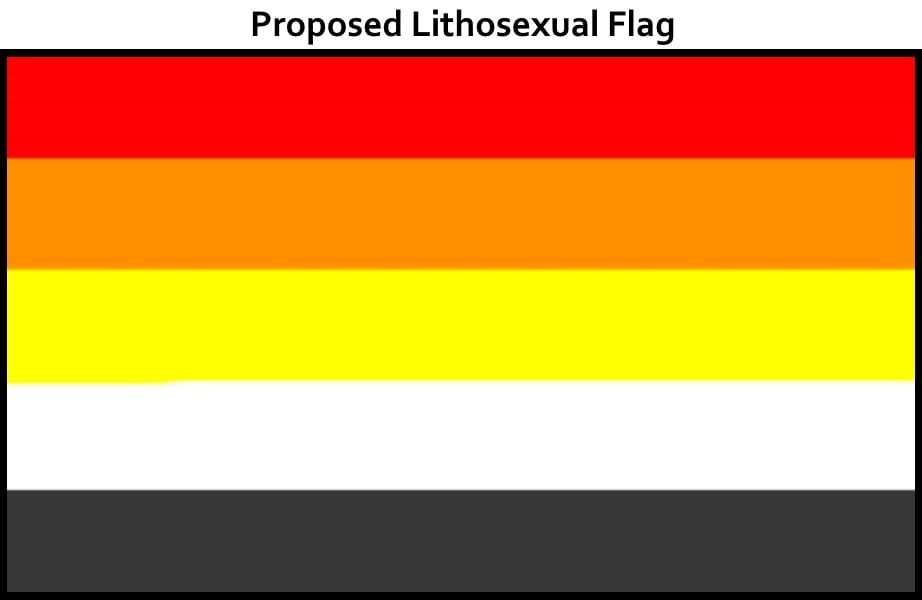Lithosexual Explanation
It is part of the sub-asexual identity spectrum which is more specific than just the asexual, allosexual or graysexual spectrum.
Flag
Meaning of the colors:
- Red – sensitivity, life, leadership, and community
- Orange – lithosexual
- Yellow – varied relationships, loyalty, honor
- White – sexuality
- Black – asexuality
Sexual Attraction
Lithsexual, like other identities in the sub-asexual, asexual or sexual identity spectrum is defined by a person’s sexual attraction – the power of evoking sexual interest or liking for someone or something. It can also be defined as sexual desire toward someone.
Basic Sexual Identity Spectrum
- Allosexual or sexual
- Heterosexual – sexual attraction to a different sex or gender.
- Homosexual – sexual attraction to the same sex or gender.
- Bisexual or pansexual – sexual attraction to multiple sexes or gender.
- Graysexual – infrequent feeling of sexual attraction
- Asexual – lack of sexual attraction toward anyone.
- Sub-asexual
- Autochorissexual – feels a disconnection between them and their sexual target
- Cupiosexual – lacks sexual attraction but desires a sexual relationship
- Demisexual – sexual attraction only after a strong emotional bond.
- Fraysexual – sexual attraction fades after meeting their target
- Lithosexual – feels sexual attraction but does not want it reciprocated.
- Placiosexual – enjoys performing sexual acts to others but has little or no desire to receive sexual acts.
- Reciprosexual – feels sexual attraction only after knowing someone is attracted to them.
Romantic Attraction
It is different from romantic attraction – the power of evoking romantic interest or liking for someone or something. It often results in a desire for a romantic relationship.
Basic Romantic Identity Spectrum
- Aromantic – lack of romantic attraction toward anyone.
- Biromantic or panromantic – romantic attraction to multiple sexes or genders.
- Heteroromantic – romantic attraction to a different sex or gender.
- Homoromantic – romantic attraction to the same sex or gender.
- Grayromantic – rarely feels or has very weak romantic attraction
Biological Sex
Biological sex is the objectively measurable organs, hormones, and chromosomes a person has. It is the female, male and the in-betweens.
Biological Sex Spectrum
- Female – vagina, ovaries, XX chromosomes, has predominant estrogen
- Male – penis, testes, XY chromosomes, has predominant testosterone
- Intersex – combination of male and female
Gender Identity
Gender identity, on the other hand, is the perception of one’s own gender or how a person sees themselves. It’s who you think you are. A person can view themselves as a woman, man, neither, both, or a combination.
Basic Gender Identity Spectrum
- Woman – perceives they fit the societal description of a woman
- Man – perceives they fit the societal description of a man
- Genderqueer – perceives they are neither, both or a combination of the two traditional gender identities
Gender Expression
Gender expression is the way a person intentionally or unintentionally demonstrates their gender through their behavior. It is interpreted by others perceiving the gender based on traditional gender roles.
Basic Gender Expression Spectrum
- Feminine – qualities or appearance traditionally associated with women
- Masculine – qualities or appearance traditionally associated with men
- Androgynous – qualities or appearance that fit neither or both women and men
References
- Bem, S. L. (1981). Gender schema theory: A cognitive account of sex typing. Psychological Review, 88, 354–364.
- Stang J, Story M. “Chapter 1. Adolescent growth and development.” Guidelines for adolescent nutrition services. Minneapolis, MN Center for Leadership, Education and Training in Maternal and Child Nutrition, Division of Epidemiology and Community Health, School of Public Health, University of Minnesota. 2005.







